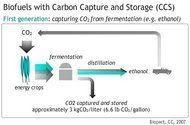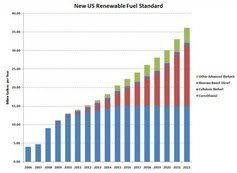Elevated CO2 changes soil microbe mix below plants; frees nutrients, allows plants to sequester more CO2
 A detailed analysis of soil samples taken from a forest ecosystem with artificially elevated levels of atmospheric carbon dioxide (CO2) reveals distinct changes in the mix of microorganisms living in the soil below trembling aspen. These changes could increase the availability of essential soil nutrients, thereby supporting increased plant growth and the plants' ability to "lock up," or sequester, excess carbon from the atmosphere. The research will be published online this week in the journal Environmental Microbiology. It confirms previously reported increases in biomass turnover rates and sustained availability and translocation of the essential nutrients required for increased plant growth under elevated CO2 - an observation with high relevance to the bioenergy and forestry sector.
A detailed analysis of soil samples taken from a forest ecosystem with artificially elevated levels of atmospheric carbon dioxide (CO2) reveals distinct changes in the mix of microorganisms living in the soil below trembling aspen. These changes could increase the availability of essential soil nutrients, thereby supporting increased plant growth and the plants' ability to "lock up," or sequester, excess carbon from the atmosphere. The research will be published online this week in the journal Environmental Microbiology. It confirms previously reported increases in biomass turnover rates and sustained availability and translocation of the essential nutrients required for increased plant growth under elevated CO2 - an observation with high relevance to the bioenergy and forestry sector.The discovered changes in soil biota are evidence for altered interactions between trembling aspen trees and the microorganisms in the surrounding soil, says Daniel van der Lelie, a biologist at the U.S. Department of Energy's (DOE) Brookhaven National Laboratory, who led the research. The findings support the idea that greater plant detritus production under elevated CO2 has altered microbial community composition in the soil. Understanding the effect these microbial changes have on ecosystem function, especially via effects on the cycling of essential elements, will be important for evaluating the potential of forests and energy crops to act as carbon sinks in mitigating the effects of rising CO2.
Atmospheric CO2, the most abundant greenhouse gas, has been increasing since the start of the industrial age, and is one of the main contributing factors associated with climate change. Since plants take in CO2 and convert it to biomass during photosynthesis, much research has focused on the potential of forests to sequester excess carbon and offset the rise in CO2.
Various studies have demonstrated increased plant growth under elevated CO2, but there is no consensus on many of the secondary effects associated with these plant responses. The goal of this study was to investigate the composition and role of microbial communities, which help to regulate the cycling of carbon and nitrogen in terrestrial ecosystems.
The study was conducted on soil samples collected at an experimental trembling aspen forest in Rhinelander, Wisconsin - home to the Aspen FACE II experiment (picture, click to enlarge). That forest is outfitted with a series rings made of large pipes that can pump a controlled amount of carbon dioxide (or other gases) into the air to artificially mimic expected environmental changes in an otherwise open-air environment. This and other similar Free-Air Carbon dioxide Enrichment (FACE) facilities around the world were developed by the Department of Energy to help estimate how plants and ecosystems will respond to increasing CO2. Before FACE, much of what scientists knew about plant and ecosystem responses to rising CO2 came from studies conducted in enclosures, where the response of plants is modified by their growth conditions:
 energy :: sustainability :: biomass :: bioenergy :: biofuels :: carbon dioxide :: carbon cycle :: carbon sequestration :: plant growth :: microorganisms :: nutrients ::
energy :: sustainability :: biomass :: bioenergy :: biofuels :: carbon dioxide :: carbon cycle :: carbon sequestration :: plant growth :: microorganisms :: nutrients :: In this study, the scientists compared the microbial content of soil taken from three FACE rings receiving ambient levels of CO2 (about 383 parts per million, as of January 2007) with that from soil taken from three FACE rings that have been receiving elevated CO2 (560 parts per million) - a level expected to be ambient on Earth in the year 2100 if the current rate of CO2 increase remains constant at 1.9 parts per million per year.
The scientists first isolated the genetic material from each soil sample. They then used molecular genetics techniques to isolate regions of genetic material known to be highly species-specific, sequenced these regions, and compared them with genetic sequence libraries of known bacteria, eukaryotic microbes (those with nuclei, such as fungi and protozoa), and archaea, a group of microbes that are genetically distinct from bacteria and often dwell in extreme environments.
Main findings
There were no differences in total abundance of bacteria or eukaryotic microbes between ambient and high CO2 soil samples. But elevated CO2 samples showed significant changes in the composition of these communities, including:
- an increase in heterotrophic decomposers - microbes that rely on an external food source and break down organic matter to recycle carbon and nitrogen
- an increase in ectomycorrhizal fungi - which gain nutrients by living in association with plant roots and help to provide the plants with essential minerals
- a decrease in fungi that commonly cause disease in plants - perhaps because increased plant growth stimulated by CO2 makes the plants less hospitable/susceptible to the fungi.
- a significant decrease in nitrate-reducers of the domain bacteria and archaea potentially implicated in ammonium oxidation.
"Overall, the changes we observed support previously reported increases in biomass turnover rates and sustained availability and translocation of the essential nutrients required for increased plant growth under elevated CO2," van der Lelie said.
This study was funded by the Office of Biological and Environmental Research within the U.S. Department of Energy's Office of Science and by the Laboratory Directed Research and Development program at Brookhaven Lab.
References:
Brookhaven National Laboratory: Elevated Carbon Dioxide Changes Soil Microbe Mix Below Plants - December 19, 2007.
Website of the Aspen FACE II experiment.
Overview of all FACE projects.
Article continues
 --------------
--------------
 PetroChina Co Ltd, the country's largest oil and gas producer, plans to invest 800 million yuan to build an ethanol plant in Nanchong, in the southwestern province of Sichuan, its parent China National Petroleum Corp said. The ethanol plant has a designed annual capacity of 100,000 tons.
PetroChina Co Ltd, the country's largest oil and gas producer, plans to invest 800 million yuan to build an ethanol plant in Nanchong, in the southwestern province of Sichuan, its parent China National Petroleum Corp said. The ethanol plant has a designed annual capacity of 100,000 tons.











Wednesday, December 19, 2007
Yanmar launches biogas micro-cogeneration business
The compact biogas power plants target livestock production facilities, small household and municipal waste treatment facilities and the food processing industry in which large streams of waste biomass are available, suitable for the production of biogas. Biogas obtained via the anaerobic digestion of organic materials consists mainly of methane and CO2. The cogeneration plants work on raw, unprocessed biogas (60-70% CH4) to yield carbon neutral energy but are more efficient when upgraded biogas ('biomethane') is utilized.
After a testing and verification process, the company's internal project team found the system to be highly reliable and efficient, with the number of sales of test-units increasing fast enough during 2006-2007, leading to the decision to launch a full commercialisation effort. The cogeneration plants will likely be priced at 12 million yen (€73,000/US$ 105,800).
The units have the following characteristics [*Japanese] (schematic, click to enlarge):
- a rated power output of 25kWh (three phase, 200V)
- an overall efficiency of over 84% in CHP-mode; an electric efficiency of 33% when biogas with an 80-90% methane content is used and 32% when raw biogas (60-70% methane) is used; a thermal efficiency of respectively 52% and 53%
- a low noise profile
- continuous operational capacity of 6000 hours per year
On an annual basis, the micro-cogeneration plant can save up to 70 tonnes of CO2 compared to a similar output obtained from fossil fuel (LPG) powered units:The calculation of the CO2 savings is based on computation methods provided by the Ministry for Environmental, Economic and Industrial Affairs and based on a typical biogas production operation.
According to Yanmar Energy System, the 1000 biogas units it hopes to sell will avoid as much CO2 as is sequestered in 5 million cedar trees, thus contributing to mitigating climate change.
Combined, the plants will generate around 50,000MWh of electricity, enough to power 40,000 homes, and 230000 MW of heat, enough to take 53,000,000 hot baths. Kerosene boilers would require around 25 million liters of the fossil fuel to heat an equivalent amount of water.
According to the company, Japan's average carbon dioxide price between April 2006 and August 2007 was 1212 Yen per ton (max. 2500 Yen, min. 900 Yen). Taking an average value, the 1000 units Yanmar hopes to sell would thus yield around 85 million Yen worth of carbon credits.
An interesting market that will be explored besides the farm and food processing sector, is that of coupling geothermal energy to methane recovery. The micro-generation units can thus be utilized as renewable home energy systems scavenging off the waste product of another form of renewable energy.
References:
Yanmar: Biogas micro-cogeneration sales to start - December 19, 2007.
Yanmar Energy System: dedicated biogas micro-cogeneration website.
JCN Network: Yanmar Unit to Fully Launch Biogas Cogeneration System - December 19, 2007.
Article continues
posted by Biopact team at 9:18 PM 0 comments links to this post
